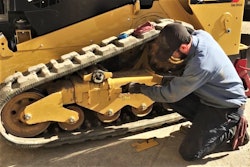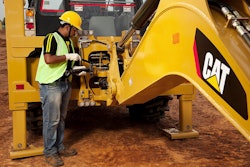
As with the weather, everybody complains about the lack of diesel equipment technicians, but nobody seems to be able to do anything about it.
The demand for diesel technicians is growing at 12 percent a year, yet trade schools aren’t training nearly enough students to meet the demand. Contractors and fleet managers can’t do much about the state of vocational education, but the help everybody needs just might be sitting right under their noses. They’re called “proxy techs,” and they’re already working for you.
A “proxy” is someone who has the authority to represent someone else – for example, a medic filling in for a doctor on a battlefield. A proxy technician is an operations person who has the additional responsibility of performing or overseeing certain maintenance and repairs on equipment. They are normally rewarded or receive extra compensation as an incentive.
A proxy tech can be anybody in your company: operators, laborers, supervisors or truck drivers. With a little guidance, they can perform small, simple, routine maintenance tasks that take up much of a technician’s workday. This frees up your trained and experienced technicians to tackle more complex problems and major repairs.
While many, if not most, of your employees may say they’re pedal-to-the-metal all day and don’t have time to work on equipment, don’t forget there are plenty of rain and weather-related delays in which many on the crews are sent home. Properly trained proxy techs could use this downtime to strengthen fleet maintenance. Additionally, don’t overlook the fact that plenty of young people are willing to work overtime or weekends to earn extra cash. And if you’re using operators to do proxy tech work, it only stands to reason they’re going to take better care of that equipment and more closely monitor the condition of their machines when they return to the joysticks.
Elements of a program
The key to tapping into this hidden potential in your workforce is to set up a program. Here is a 10-point list of what you need to develop a good proxy tech program:
1. Define the tasks, boundaries and limits of what your proxy techs should do.
2. Assess the skills and knowledge needed to accomplish these tasks.
3. Develop a process to train proxy techs.
4. Set up a selection and screening process.
5. List the tools and resources needed.
6. Detail the parts they need, something like an “uptime kit.”
7. Develop evaluation protocols.
8. Create a system to record the work being done by proxy techs.
9. Develop Key Performance Indicators to prove value with beginning baselines.
10. Develop compensation and reward standards.
Possible tasks
Each company, its equipment and needs are unique, so you’ll want to spend time on the first program element – defining what your proxy techs do – and look hard for opportunities. Here are some examples of simple tasks common to most earthmoving equipment, paving and truck maintenance facilities:
• Check and replace fuses
• Replace lightbulbs and beacon lights
• Change two-wire switches
• Replace batteries
• Check hydraulic quick connects, O-rings and hoses
• Drain fuel-water separator and change filters
• Install or tighten loose bolts and pins
• Tighten or replace fasteners
• Replace air filters
• Inspect and replace seat belts if needed
• Inspect and replace rear view mirrors if needed
• Check engine oil levels
• Draw and process oil samples
• Inspect and top off coolant if necessary
• Check tire pressure
• Inspect tires for wear or damage
• Check track tension and wear on undercarriages
• Grease zerks
• Safety check to ensure horn, backup alarm and lights work.
With a more advanced training program and assistance from an experienced mechanic, proxy techs could also take on more complicated tasks, such as:
• Replace blades, buckets or cutting edges on equipment. Replace brooms on sweeping equipment.
• Adjust tension on dozer, compact track loader and excavator tracks.
• On pavers, inspect and adjust or replace, if necessary, front hopper rubber, augers, end gate wear plates and flight chains.
• On material transport vehicles and road wideners, inspect, adjust or replace front hopper rubber, bearings and chains.
• On milling machines, inspect, adjust or replace mold board wear blade, drum wear plates, track pads, conveyor belts or assist with drum swaps.
• On rollers, inspect, adjust or replace scrappers, cocoa mats, spray nozzles, filters.
• On tack trucks, inspect, adjust or replace spray bars, nozzles and mud flaps.
Testing and training requirements
You’ll need to test your proxy techs before you select them for the work. Some people are all thumbs, and some have a knack for mechanic work.
To start your selection process, look for candidates who have shown a desire or interest in working on equipment. Employees who have some background, whether it’s tinkering with trucks, motorcycles or farm equipment, are usually good candidates. You should also select candidates who have been with the company at least six months.
The Bennett Mechanical Comprehension Test is a good resource to use in the selection process. The BMCT can help identify candidates with good spatial perception and mechanical reasoning, as well as whether they have an aptitude for learning mechanical processes and tasks. Candidates can take the test online for $20. For more information go to: http://bit.ly/ZUNEVR6
Once candidates have been identified, your company fleet manager or shop foreman should develop the curriculum and conduct the proxy tech training. A two-day program should be enough to get the ball rolling. If your senior shop people aren’t comfortable training others, suggest they take a “train-the-trainer” course so they know how to communicate effectively. Google “train-the-trainer” and you’ll find plenty of resources for this. Another option is calling on vendors or outsiders like a community college or tech school to provide the training.
Training should cover the basics of electrical systems (both AC and DC), understanding of fasteners, hydraulics, power train systems and lubrication principles. When the opportunity arises, outside training from OEMs can be valuable. These offerings are limited but essential for a proxy tech to understand basic mechanical, hydraulic and electrical systems.
Supplement your classroom training with on-the-job demonstrations, and assign each student proxy tech a mentor or coach to go to with questions.
Also, make sure your proxy techs understand the CLAIRE system. CLAIRE stands for clean, lubricate, adjust, inspect, repair and eliminate. This six-step process helps ensure a successful operation for preventive maintenance. For more on the CLAIRE process, see this article.
Incentives
There are a variety of ways to motivate proxy techs. Some companies pay an extra dollar an hour for the additional duties. One company I’ve worked with set a reward based on the goal of three repairs per month per proxy, resulting in a $100 gift certificate.
If other crew members aid or assist the proxy with a repair, a lunch reward up to $150 in value for all participants could be provided. Repairs must be documented on a work order to qualify for recordkeeping purposes.
Key performance indicators
Any program like this should have key performance indicators built in to gauge its effectiveness and to sell the idea to upper management. To judge the value of a proxy tech program you should use various metrics or measures to gauge performance and costs. You’ll need to establish baselines before you start monitoring the effectiveness of your proxy techs. Here are some common measurements to consider:
• Ratio of labor dollars to material dollars. In world-class operations, this ratio is typically .75 to 1. With a proxy tech program, you should see a reduction in labor dollars versus material dollars.
• Mean time to repair. This is a simple calculation of the average time it takes to execute a repair, including any delays.
• Emergency maintenance response time.
• Number of proxy repairs performed without callbacks in a 30-day period.
• Customer satisfaction survey.
• Crew maintenance cost per dollar of revenue.
Proxy techs can’t replace good, well-trained mechanics – no more than an Army medic or Navy corpsman can replace a surgeon. But knowing you have someone on a dirt crew, bridge job or paving crew capable of performing basic maintenance can maximize the talent and productivity of your full-time shop technicians and reduce downtime in the field.










